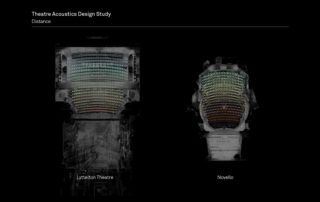Fred Pilbrow
Tal Ben-Amar
Ralf Lindemann
Nick Stone
Presenting for Pilbrow & Partners, Fred Pilbrow drew on his recent experience with various auditoria to suggest that the “unhealthy passion for data” can all too easily override more significant aspects in their design. Citing his practice’s current project to convert a former Granada cinema in Walthamstow into a multi-hall venue, and the refurbishment of Margate’s Theatre Royal, he stressed how deciding what not to do can be as important as what interventions are made.
A comparative analysis of seating capacities and hall volumes was especially revealing, with for example, the National Theatre’s Olivier offering more than 13 cubic metres per seat, far more than most Victorian theatres. With fewer reflection opportunities, sound will tend to dissipate in a large hall, and the acoustic will suffer without the artificial assistance of technology. Contrarily, he acknowledged, the site lines of the Olivier were very good, so there is inevitably a fine balance to be sought between egalitarianism and acoustic quality. To accommodate an audience greater than say 400, Pilbrow suggested, will inevitably require some compromise.
In the end, suggested Pilbrow, the goal of theatre design is not so much a perfect acoustic environment, but the creation of a sense of intimacy – both among the audience and between the audience and the performers – in which sound plays a part, in concert with other senses.





















